The food and beverage industry software market is growing at USD 7,820 million in 2025 and expected to reach USD 11,354.8 million by 2035, advancing at a CAGR of 3.8%. A rolling CAGR analysis reveals the stability of expansion phases across the decade. From 2020 to 2025, revenue increases from USD 6,489.6 million to USD 7,820.0 million, reflecting a rolling CAGR of approximately 3.8%. This steady start shows strong early adoption as food manufacturers, distributors, and retailers integrate software for supply chain visibility, compliance, and operational efficiency.
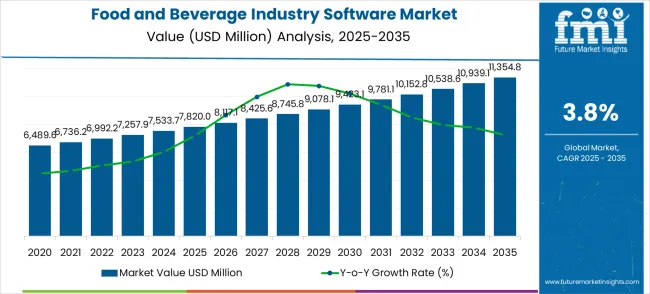
| Metric | Value |
|---|---|
| Market Value (2025) | USD 7,820 million |
| Market Forecast Value (2035) | USD 11,354.8 million |
| Market Forecast CAGR | 3.8% |
Between 2025 and 2030, the market grows from USD 7,820.0 million to USD 9,423.1 million, with a rolling CAGR again close to 3.8%. This period represents the middle growth phase where adoption broadens, especially in mid-sized companies and regional food processors seeking automation and analytics capabilities. Rolling CAGR consistency highlights a stable trajectory with no volatility in demand. The focus during these years is on digital inventory tracking, quality monitoring, and predictive analytics, reinforcing the continued role of software platforms in optimizing food industry operations.
From 2030 to 2035, revenue expands from USD 9,423.1 million to USD 11,354.8 million, maintaining a rolling CAGR of about 3.8%. This demonstrates that growth remains steady even in the mature stage of adoption. The market reflects a saturation-driven expansion where most enterprises have implemented core software solutions, and incremental growth is driven by upgrades, cloud migrations, and advanced AI-enabled modules. Rolling CAGR stability confirms the market’s resilience and predictable expansion, signaling to stakeholders that long-term adoption is assured without sharp fluctuations in growth momentum.
Market expansion is being supported by the continuous increase in digital transformation initiatives worldwide and the corresponding need for integrated software solutions that provide superior operational efficiency capabilities and regulatory compliance reliability for critical food manufacturing and beverage production applications. Modern food processing facilities and beverage manufacturers rely on consistent data integration and process automation to ensure optimal operational performance including inventory management, quality control, and supply chain optimization. Even minor system inefficiencies can require comprehensive process adjustments to maintain optimal production standards and regulatory compliance.
The growing complexity of food safety regulations and increasing demand for comprehensive traceability solutions are driving demand for industry software from certified providers with appropriate functionality capabilities and technical expertise. Food manufacturers are increasingly requiring documented compliance capabilities and real-time monitoring standards to maintain food safety quality and operational efficiency. Regulatory frameworks and industry standards are establishing standardized software procedures that require specialized food industry technologies and trained system administrators.
The Food and Beverage Industry Software market is entering a steady growth phase, driven by demand for digital transformation, operational efficiency, and evolving regulatory compliance and sustainability standards. By 2035, these pathways together can unlock USD 1,200-1,500 million in incremental revenue opportunities beyond baseline growth.
Pathway A -- Deployment Innovation Leadership (Cloud-Based Solutions) The cloud-based segment already holds the largest share due to its flexibility and cost efficiency. Expanding integration capabilities, security features, and customization options can consolidate leadership. Opportunity pool: USD 300-400 million.
Pathway B -- Enterprise Market Expansion (Large-Scale Operations) Large enterprises account for the largest demand. Growing food industry consolidation and multinational expansion, especially in emerging economies, will drive higher adoption of comprehensive software platforms for operational management. Opportunity pool: USD 250-320 million.
Pathway C -- SME Market Development (Small and Medium Enterprises) SMEs represent significant growth potential with increasing digitalization needs. Solutions optimized for smaller operations and cost-sensitive implementations can capture substantial growth. Opportunity pool: USD 200-250 million.
Pathway D -- Emerging Market Expansion Asia-Pacific and Latin America present growing demand due to food industry development. Targeting scalable solutions and regional partnerships will accelerate adoption. Opportunity pool: USD 150-200 million.
Pathway E -- Specialty Application Integration with increasing focus on sustainability and traceability, there is an opportunity to promote software optimized for environmental tracking and supply chain transparency. Opportunity pool: USD 120-150 million.
Pathway F -- Industry-Specific Solutions (Beverage & Specialty Foods) Software optimized for beverage production, organic foods, and specialty manufacturing offer premium positioning for niche market sectors. Opportunity pool: USD 80-100 million.
Pathway G -- Advanced Analytics & AI Services Recurring revenue from predictive analytics, demand forecasting, and intelligent optimization creates long-term engagement streams. Opportunity pool: USD 60-75 million.
Pathway H -- Integration Services & Consulting Professional implementation services, system integration, and ongoing optimization consulting can elevate software into comprehensive digital transformation solutions. Opportunity pool: USD 40-50 million.
The market is segmented by deployment type, application, and region. By deployment type, the market is divided into cloud-based and on-premise software solutions. Based on application, the market is categorized into large enterprises, small and medium enterprises (SMEs), and other organizational applications. Regionally, the market is divided into North America, Europe, East Asia, South Asia & Pacific, Latin America, and Middle East & Africa.
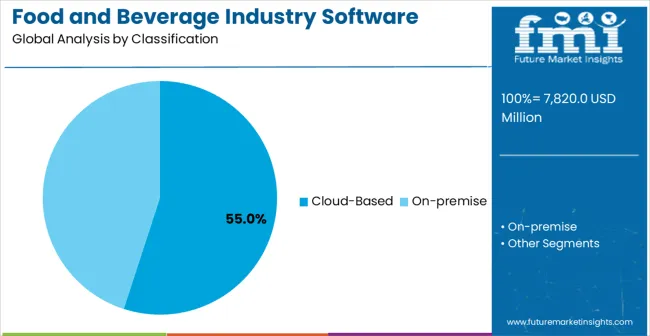
In 2025, the cloud-based deployment segment is projected to capture around 55% of the total market share, making it the leading deployment type category. This dominance is largely driven by the widespread adoption of software-as-a-service solutions that provide optimal balance between cost efficiency and scalability capability, catering to a wide variety of food manufacturing and beverage production applications. Cloud-based solutions are particularly favored for their ability to deliver superior flexibility and accessibility in both multi-location manufacturing and distributed supply chain installations, ensuring system availability and remote management capabilities. Food processing companies, beverage manufacturers, ingredient suppliers, and food service applications increasingly prefer this deployment model, as it meets demanding operational requirements without imposing excessive infrastructure costs or maintenance complexity.
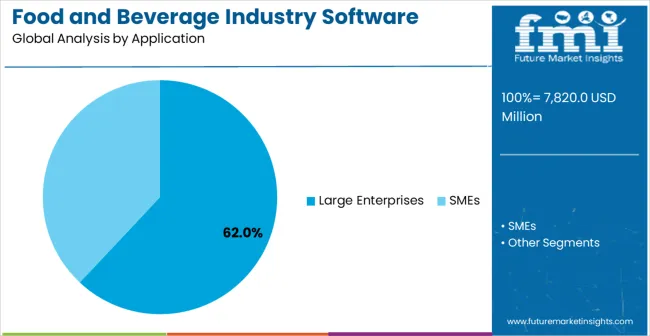
The large enterprises segment is expected to represent 62% of food and beverage industry software demand in 2025, highlighting its position as the most significant application sector. This dominance stems from the complex operational requirements of major food and beverage corporations, where comprehensive system integration and advanced functionality are essential to multi-facility management and global supply chain coordination. Large enterprises often feature extensive production networks that demand sophisticated software platforms throughout complex organizational structures, requiring scalable and feature-rich business solutions. Industry software is particularly well-suited to these environments due to its ability to provide consistent data management and process standardization, even during high-volume production operations and varying regulatory requirements. As food industry consolidation continues globally and emphasizes improved operational efficiency standards, the demand for enterprise-grade software solutions continues to rise.
The Food and Beverage Industry Software market is advancing steadily due to increasing regulatory compliance requirements and growing recognition of integrated software advantages over traditional manual systems in food safety and operational efficiency applications. The market faces challenges including higher implementation costs compared to basic systems, need for specialized training and change management procedures, and complex integration requirements with existing production equipment across different manufacturing environments. Digital transformation efforts and advanced analytics technology programs continue to influence software development and market adoption patterns.
The growing development of Internet of Things connectivity and enhanced sensor integration is enabling superior operational visibility with improved real-time data collection and automated quality control processes. Advanced IoT applications and optimized sensor networks provide superior production monitoring while maintaining operational efficiency requirements. These technologies are particularly valuable for food manufacturers who require reliable process monitoring capabilities that can support extensive production operations with consistent real-time insights.
Modern food industry software providers are incorporating advanced AI-driven analytics capabilities and intelligent prediction systems that enhance operational efficiency and quality management effectiveness. Integration of machine learning algorithms and optimized data processing systems enables superior demand forecasting and comprehensive quality assurance capabilities. Advanced AI features support operation in diverse production environments while meeting various regulatory requirements and efficiency specifications.
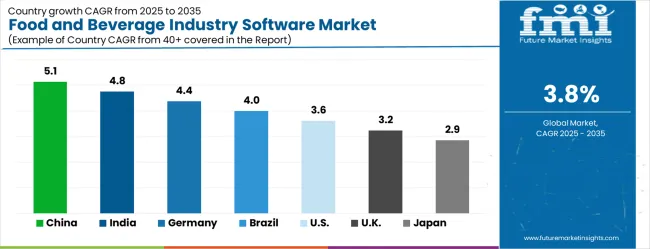
| Country | CAGR (2025-2035) |
|---|---|
| China | 5.1% |
| India | 4.8% |
| Germany | 4.4% |
| Brazil | 4.0% |
| United States | 3.6% |
| United Kingdom | 3.2% |
| Japan | 2.9% |
The food and beverage industry software market is growing consistently, with China leading at a 5.1% CAGR through 2035, driven by rapid food industry modernization and increasing adoption of digital manufacturing solutions. India follows at 4.8%, supported by expanding food processing sector and growing implementation of enterprise software technologies. Germany grows strongly at 4.4%, integrating advanced software technology into its established food manufacturing infrastructure. Brazil records 4.0%, emphasizing food industry digitalization and operational efficiency enhancement initiatives. The United States shows solid growth at 3.6%, focusing on advanced analytics and regulatory compliance solutions. The United Kingdom demonstrates steady progress at 3.2%, maintaining established food manufacturing applications. Japan records 2.9% growth, concentrating on technology advancement and operational optimization.
The report covers an in-depth analysis of 40+ countries top-performing countries are highlighted below.
Revenue from food and beverage industry software in China is projected to exhibit the highest growth rate with a CAGR of 5.1% through 2035, driven by unprecedented food industry expansion and increasing demand for comprehensive digital manufacturing solutions. The country's massive food processing sector and expanding beverage production facilities are creating enormous demand for advanced software platform solutions. Major food manufacturers are establishing comprehensive digital transformation systems to support the increasing requirements of production facilities and supply chain companies across metropolitan industrial zones.
Government food industry development initiatives are supporting establishment of modern manufacturing facilities and advanced digitalization complexes, driving demand for high-performance software platforms throughout major food production corridors. Food industry modernization programs are facilitating adoption of software technologies that enhance operational efficiency and food safety standards across manufacturing infrastructure networks.
Revenue from food and beverage industry software in India is expanding at a CAGR of 4.8%, supported by increasing food processing sector development and growing implementation of enterprise software technologies. The country's expanding food manufacturing industry and rising operational efficiency standards are driving demand for advanced software platform solutions. Food processing companies and beverage manufacturers are gradually implementing comprehensive software systems to maintain competitive standards and regulatory compliance.
Food industry growth and digital infrastructure development are creating opportunities for suppliers that can support diverse operational requirements and cost-effective specifications. Professional training and technical programs are building expertise among IT personnel, enabling effective utilization of industry software technology that meets operational standards and efficiency requirements.
Demand for food and beverage industry software in Germany is projected to grow at a CAGR of 4.4%, supported by the country's emphasis on food manufacturing quality standards and advanced software technology adoption. German food processing facilities and beverage manufacturers are implementing sophisticated software systems that meet stringent performance requirements and regulatory specifications. The market is characterized by focus on operational efficiency, quality assurance excellence, and compliance with comprehensive food safety standards.
Food manufacturing industry investments are prioritizing cutting-edge software technology that demonstrates superior performance and reliability while meeting German quality and regulatory standards. Professional certification programs are ensuring comprehensive technical expertise among IT personnel, enabling specialized software capabilities that support diverse food manufacturing applications and regulatory requirements.
Revenue from food and beverage industry software in Brazil is growing at a CAGR of 4%, driven by increasing food industry infrastructure development and growing recognition of digital transformation advantages. The country's expanding food processing sector is gradually integrating advanced software solutions to enhance operational efficiency and regulatory compliance. Food manufacturing facilities and beverage producers are investing in software technology to address evolving operational requirements and competitive standards.
Food industry infrastructure modernization is facilitating adoption of advanced software technologies that support comprehensive operational capabilities across food processing regions. Professional development programs are enhancing technical capabilities among IT personnel, enabling effective software utilization that meets evolving industry standards and performance requirements.
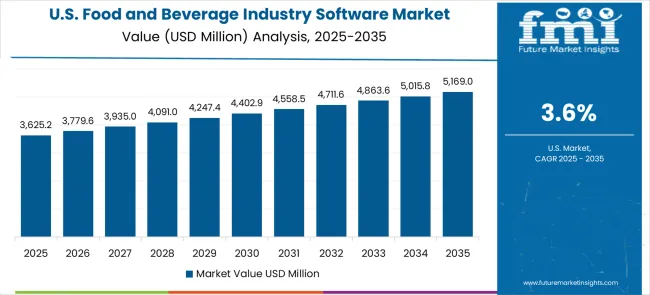
Demand for food and beverage industry software in the USA is expanding at a CAGR of 3.6%, driven by established food manufacturing industries and growing emphasis on operational optimization. Large food corporations and beverage companies are implementing comprehensive software capabilities to serve diverse operational requirements. The market benefits from established food industry infrastructure distribution systems and professional development programs that support various manufacturing and supply chain applications.
Food industry leadership is enabling standardized software utilization across multiple facility types, providing consistent performance standards and comprehensive operational coverage throughout regional markets. Professional development and certification programs are building specialized technical expertise among IT personnel, enabling effective software utilization that supports evolving food manufacturing and beverage production requirements.
Demand for food and beverage industry software in the UK is projected to grow at a CAGR of 3.2%, supported by established food manufacturing sectors and growing emphasis on operational efficiency capabilities. British food processing facilities and beverage service providers are implementing software systems that meet industry performance standards and regulatory requirements. The market benefits from established food manufacturing infrastructure and comprehensive training programs for technical professionals.
Food manufacturing facility investments are prioritizing advanced software solutions that support diverse operational applications while maintaining established performance and compliance standards. Professional development programs are building technical expertise among IT personnel, enabling specialized software operation capabilities that meet evolving facility requirements and performance standards.
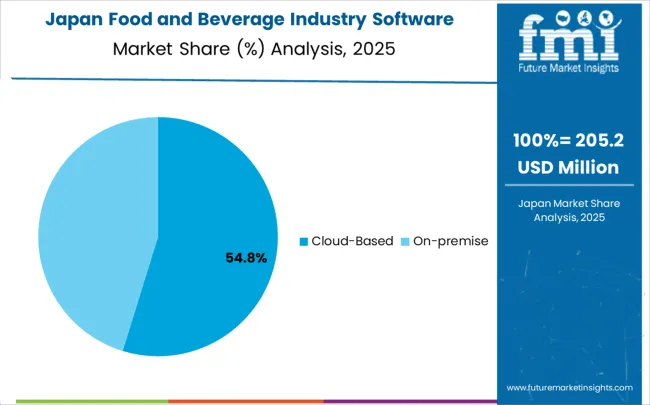
Revenue from food and beverage industry software in Japan is growing at a CAGR of 2.9%, driven by the country's focus on food technology innovation and operational efficiency applications. Japanese food manufacturing facilities and beverage companies are implementing advanced software systems that demonstrate superior performance reliability and operational consistency. The market is characterized by emphasis on technological excellence, quality assurance precision, and integration with established manufacturing workflows.
Food technology investments are prioritizing innovative software solutions that combine advanced operational management technology with precision data processing while maintaining Japanese quality and efficiency standards. Professional development programs are ensuring comprehensive technical expertise among IT personnel, enabling specialized software capabilities that support diverse food manufacturing applications and operational requirements.
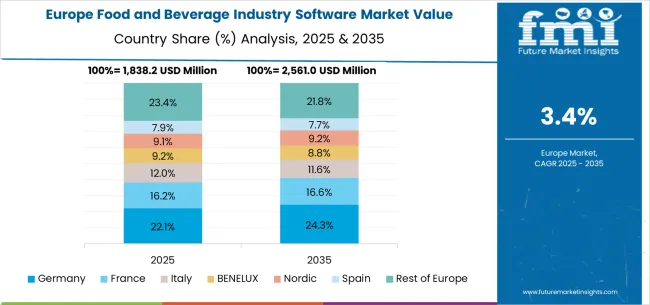
The food and beverage industry software market in Europe is forecast to expand from USD 2,046.5 million in 2025 to USD 2,972.3 million by 2035, registering a CAGR of 3.8%. Germany will remain the largest market, holding 28.9% share in 2025, easing to 28.4% by 2035, supported by strong food manufacturing infrastructure and advanced software adoption standards. The United Kingdom follows, rising from 21.8% in 2025 to 22.2% by 2035, driven by food facility modernization and operational efficiency enhancement initiatives. France is expected to maintain stability from 18.3% to 18.1%, reflecting consistent food industry investments and software requirements. Italy holds around 13.1% throughout the forecast period, supported by food manufacturing facility upgrades and operational system modernization programs. Spain grows from 9.4% to 9.7% with expanding food processing infrastructure and increased focus on comprehensive software solutions. BENELUX markets maintain 5.1% to 4.9%, while the remainder of Europe hovers near 3.4%--3.3%, balancing emerging Eastern European food industry development against mature Nordic markets with established software technology adoption patterns.
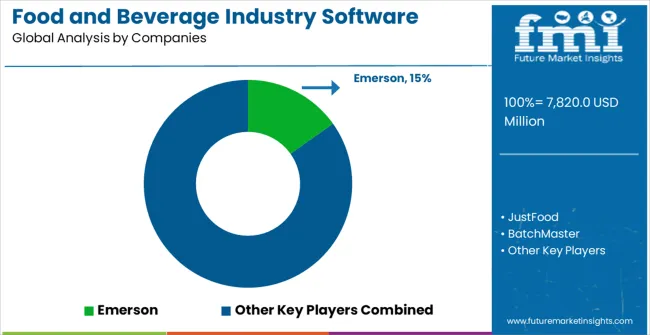
The Food and Beverage Industry Software market is defined by competition among specialized ERP providers, industry-specific software companies, and enterprise solution vendors. Companies are investing in advanced integration technology development, cloud platform innovation, AI-powered analytics optimization, and comprehensive consulting service capabilities to deliver scalable, efficient, and industry-tailored software solutions. Strategic partnerships, technological innovation, and vertical market expansion are central to strengthening product portfolios and market presence.
Emerson offers comprehensive industrial software solutions with established automation expertise and professional-grade integration capabilities. JustFood provides specialized food industry software with focus on operational efficiency and regulatory compliance. BatchMaster delivers advanced manufacturing software with emphasis on batch processing optimization and recipe management. NetSuite specializes in cloud-based ERP technology with advanced scalability capabilities.
Plex offers professional-grade manufacturing software with comprehensive supply chain integration capabilities. Katana Technologies delivers established production management solutions with advanced inventory optimization technologies. Chetu provides specialized custom software development with focus on industry-specific solutions. Infor, inecta LLC, SYSPRO, VicinityFood, FoodBusiness ERP, IFS, iMonitor, Revalize Inc., Sage Group, Dassault Systèmes - SolidWorks Corporation, Advantive, Centric Software Inc., and Aptean offer specialized software expertise, platform reliability, and comprehensive development across global and regional food industry market segments.
| Item | Value |
|---|---|
| Quantitative Units | USD 7,820 million |
| Deployment Type | Cloud-Based, On-premise |
| Application | Large Enterprises, SMEs |
| Regions Covered | North America, Europe, East Asia, South Asia & Pacific, Latin America, Middle East & Africa |
| Country Covered | China, India, Germany, Brazil, United States, United Kingdom, Japan, and 40+ countries |
| Key Companies Profiled | Emerson, JustFood, BatchMaster, NetSuite, Plex, Katana Technologies, Chetu, Infor, inecta LLC, SYSPRO, VicinityFood, FoodBusiness ERP, IFS, iMonitor, Revalize Inc., Sage Group, Dassault Systèmes - SolidWorks Corporation, Advantive, Centric Software Inc., Aptean |
| Additional Attributes | Dollar sales by deployment type and application segment, regional demand trends across major markets, competitive landscape with established software providers and emerging technology vendors, customer preferences for different deployment configurations and functionality options, integration with manufacturing systems and supply chain protocols, innovations in cloud technology and AI-powered analytics efficiency, and adoption of advanced IoT features with enhanced real-time monitoring capabilities for improved operational workflows. |
The global food and beverage industry software market is estimated to be valued at USD 7,820.0 million in 2025.
The market size for the food and beverage industry software market is projected to reach USD 11,354.8 million by 2035.
The food and beverage industry software market is expected to grow at a 3.8% CAGR between 2025 and 2035.
The key product types in food and beverage industry software market are cloud-based and on-premise.
In terms of application, large enterprises segment to command 62.0% share in the food and beverage industry software market in 2025.






Our Research Products

The "Full Research Suite" delivers actionable market intel, deep dives on markets or technologies, so clients act faster, cut risk, and unlock growth.

The Leaderboard benchmarks and ranks top vendors, classifying them as Established Leaders, Leading Challengers, or Disruptors & Challengers.

Locates where complements amplify value and substitutes erode it, forecasting net impact by horizon

We deliver granular, decision-grade intel: market sizing, 5-year forecasts, pricing, adoption, usage, revenue, and operational KPIs—plus competitor tracking, regulation, and value chains—across 60 countries broadly.

Spot the shifts before they hit your P&L. We track inflection points, adoption curves, pricing moves, and ecosystem plays to show where demand is heading, why it is changing, and what to do next across high-growth markets and disruptive tech

Real-time reads of user behavior. We track shifting priorities, perceptions of today’s and next-gen services, and provider experience, then pace how fast tech moves from trial to adoption, blending buyer, consumer, and channel inputs with social signals (#WhySwitch, #UX).

Partner with our analyst team to build a custom report designed around your business priorities. From analysing market trends to assessing competitors or crafting bespoke datasets, we tailor insights to your needs.
Supplier Intelligence
Discovery & Profiling
Capacity & Footprint
Performance & Risk
Compliance & Governance
Commercial Readiness
Who Supplies Whom
Scorecards & Shortlists
Playbooks & Docs
Category Intelligence
Definition & Scope
Demand & Use Cases
Cost Drivers
Market Structure
Supply Chain Map
Trade & Policy
Operating Norms
Deliverables
Buyer Intelligence
Account Basics
Spend & Scope
Procurement Model
Vendor Requirements
Terms & Policies
Entry Strategy
Pain Points & Triggers
Outputs
Pricing Analysis
Benchmarks
Trends
Should-Cost
Indexation
Landed Cost
Commercial Terms
Deliverables
Brand Analysis
Positioning & Value Prop
Share & Presence
Customer Evidence
Go-to-Market
Digital & Reputation
Compliance & Trust
KPIs & Gaps
Outputs
Full Research Suite comprises of:
Market outlook & trends analysis
Interviews & case studies
Strategic recommendations
Vendor profiles & capabilities analysis
5-year forecasts
8 regions and 60+ country-level data splits
Market segment data splits
12 months of continuous data updates
DELIVERED AS:
PDF EXCEL ONLINE
Food Grade Crosslinked Polyvinylpolypyrrolidone (PVPP) Market Size and Share Forecast Outlook 2025 to 2035
Food Grade Cassia Gum Powder Market Size and Share Forecast Outlook 2025 to 2035
Food Grade Dry Film Lubricant Market Size and Share Forecast Outlook 2025 to 2035
Foodservice Equipment Market Analysis - Size, Share, and Forecast Outlook 2025 to 2035
Food Basket Market Forecast and Outlook 2025 to 2035
Food Grade Tremella Polysaccharide Market Size and Share Forecast Outlook 2025 to 2035
Food Sorting Machine Market Size and Share Forecast Outlook 2025 to 2035
Foodservice Paper Bag Market Size and Share Forecast Outlook 2025 to 2035
Food Stabilizers Market Size and Share Forecast Outlook 2025 to 2035
Food Packaging Film Market Size and Share Forecast Outlook 2025 to 2035
Food Certification Market Size and Share Forecast Outlook 2025 to 2035
Food Tray Market Size and Share Forecast Outlook 2025 to 2035
Food Technology Market Size and Share Forecast Outlook 2025 to 2035
Food Tourism Sector Market Size and Share Forecast Outlook 2025 to 2035
Food Processing Boiler Market Size and Share Forecast Outlook 2025 to 2035
Food Packaging Machines Market Size and Share Forecast Outlook 2025 to 2035
Food Minerals Market Size and Share Forecast Outlook 2025 to 2035
Food Packaging Films Market Size and Share Forecast Outlook 2025 to 2035
Food Can Coatings Market Size and Share Forecast Outlook 2025 to 2035
Food Fortifying Agents Market Size and Share Forecast Outlook 2025 to 2035

Thank you!
You will receive an email from our Business Development Manager. Please be sure to check your SPAM/JUNK folder too.
Chat With
MaRIA